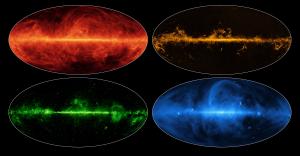Blog
Light in Motion
18 February 2015
 ESA
ESAOften in astronomy we’ll show false color images of celestial objects to enhance the visual appeal, or to show how an object appears at different wavelengths. While it might look like the above image is a similar multi-wavelength view, it’s actually much more sophisticated. Rather than simply being a few at different wavelengths, the four images of the Milky Way are each focused on the origin of the light in question, and each tells a particular story about our galaxy.
The red image in the upper left is light that follows a thermal spectrum (what we call blackbody radiation). In this case the source of the light has a temperature of about 20 K. This is the temperature of much of the interstellar dust in our galaxy, so this image shows the distribution of dust in the Milky Way. The central band is the plane of our galaxy, and is where most of the dust lies, though it’s clear that most of the sky is somewhat dusty. This is the main reason why efforts to observe effects of inflation in the cosmic microwave background have been so problematic.
The yellow image in the upper right is light emitted at a specific radio wavelength emitted by carbon monoxide. Wherever you see that wavelength, you know carbon monoxide is there. Carbon monoxide is abundant in stellar nurseries, and where stars are actively forming. Carbon monoxide is much less abundant than hydrogen in these regions, but light from hydrogen is much more dim.
The green image in the lower left is a bit more complicated. It shows thermal bremsstrahlung light, formed when particles collide with each other. The light is also known as free-free emissions, because it is produced by electrons colliding with hydrogen ions and not getting captured to form neutral hydrogen. Thus the electrons and ions are “free” both before and after the collision. Like thermal blackbody emissions, thermal bremsstrahlung can be identified by its overall spectrum. Free-free emissions typically occur where there is hot, ionized gas, such as near massive stars.
The last image in blue shows a type of light known as synchrotron radiation. When charged particles move through a magnetic field, they begin to move in a helix along the magnetic field lines. As they are accelerated in a circle they emit synchrotron radiation. This radiation is brightest when high-energy electrons are trapped in strong galactic magnetic fields. So the image show how the Milky Way’s magnetic field traps high energy electrons produced by things such as supernovae.
With all these images combined we can see where material is, where it’s collapsing under gravity, where it’s heating up, and where it’s energized. It’s a view of our galaxy that extends far beyond simply looking at images from different wavelengths. From the cosmic light we can learn not only what’s there, but also what it’s doing.